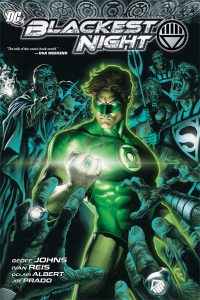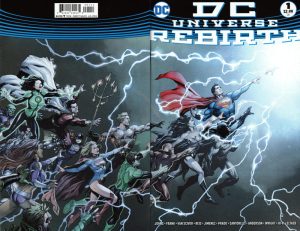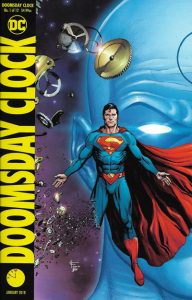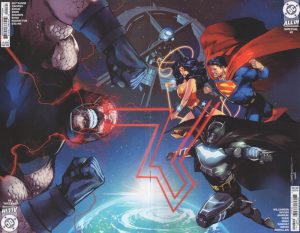 In 2016, I was basically out of comics. I was a DC kid, had been ever since I’d met Geoff Johns after reading Blackest Night at the tender age of 12. Good times. I only had a short window to appreciate the world I had stumbled into, however, before DC started up the New 52. Now, I’m known to be hyperbolic, so let me get down to earth for a moment: the New 52 was fine.
In 2016, I was basically out of comics. I was a DC kid, had been ever since I’d met Geoff Johns after reading Blackest Night at the tender age of 12. Good times. I only had a short window to appreciate the world I had stumbled into, however, before DC started up the New 52. Now, I’m known to be hyperbolic, so let me get down to earth for a moment: the New 52 was fine.
I’ll pause for a moment while anyone who knows me finds their monocles.
While it had more than its fair share of problems, some of which we’re still dealing with today, at the height of the Great Recession, the New 52 was actually a pretty savvy business move. Everyone was hurting back in 2011; DC needed a way to make their comics worth people’s limited time and money. Solution? A two-year initiative of DC’s heroes in a reimagined universe, free of the burdens of continuity, to introduce new readers to these characters in the same way Ultimate Spider-Man had helped to reinvigorate Marvel at the turn of the millennium. From this era, we got Snyder’s Batman, Geoff Johns’ Justice League, Grant Morrison’s Action Comics, and more. There was genuinely good stuff during the New 52.
So, what went wrong? Why was I disillusioned? Well… Note that I said it was a two-year initiative. Now those of you who are versed in the dark arts of mathematics will note that 2016 – 2011 does not equal 2 years. See the plan originally was to end it with the storyline we now know as Trinity War, with Justice League, Justice League International (replaced later by Justice League of America), and Justice League Dark throwing down over Pandora’s Box which would then be opened to release all the evils within (and all the previous continuity) back into the universe. However, it was at this point that editorial had a schism. The New 52 was still going relatively strong. Those who wanted to stick to the original plan were overruled by the almighty dollar, and so Trinity War led into Forever Evil instead.
As it turned out, Forever Evil would pretty much be the peak of the summit. From what little I know personally, just as the decision to start the New 52 was controversial, the decision to continue it was likewise subject to rigorous internal debate, including from some of the New 52’s own rising stars. A lot of writers simply didn’t have a lot of interest in continuing past the point that had been agreed upon, which is why the next few years feel pretty scattershot and schizophrenic. Editorial took a greater hand in on the ground creative decisions, synergy became a bigger priority as they tried to get the movies off the ground, and ultimately conflicting visions led to them smackdab back where they started: looking for that big hook to reel in new readers, as well as old ones (like me) who felt like they’d lost their way.
 And that hook came from none other than Geoff Johns. It was one word long: Rebirth.
And that hook came from none other than Geoff Johns. It was one word long: Rebirth.
Swinging for the fences, Johns proposed an initiative which would see past and present DC collide. He acknowledged the missing history of DC Comics that the New 52 wiped away, and revealed that there were those in-universe who knew that their world had been sabotaged. The next overarching DC story would itself be about reclaiming their lost history and rediscovering who they are and what they stand for. But who could possibly be responsible for all this? Darkseid? Anti-Monitor? The oft-forgotten but equally dangerous Penny Plunderer (look it up)?
No. For something like this, something which was so metatextual as to make their business strategy the literal storyline, you needed someone no one would ever see coming. Someone all-powerful, someone all-knowing, and someone who actually said something about the state of comics as a medium.
You needed Dr. Manhattan.
I remember gasping aloud when I saw the Watchmen pin on the Batcave wall. I had to know where this was going. What followed was what I still believe to be DC’s strongest launch in recent memory, with a cavalcade of writers and artists, some old guard, some new blood, all dedicated to bringing DC back into fighting shape. For the vast majority of titles, this was a resounding success, and I should know, I picked up every single one of them. For almost two years, DC could chalk up win after win, so much so that Marvel even tried to mimic their success with Marvel Legacy, to mixed results. Johns was promoted to President of the company, a role left vacant since the departure of Paul Levitz just before the New 52, and it was all set to culminate in Doomsday Clock. Just as Watchmen deconstructed comics, Doomsday Clock would deconstruct Watchmen’s complicated legacy, and complete the restoration. It was set to be the capstone in a brilliant comeback.
And then… It wasn’t.
 Don’t get me wrong: Doomsday Clock was great. It conclusively ended the Rebirth narrative arc on an extremely positive note and achieved its metatextual goals in the process. The problem was that, by the time it finished, the situation had changed dramatically behind the scenes. Stop me if this starts to sound familiar. What began with a clear vision was complicated by editorial infighting, so much so that they apparently were just flat out not talking to each other at some points. Johns, who at the same time had become the fall guy for the struggles of DC Films, realized he hated his job trying to manage it all and jumped ship to pursue work he found creatively fulfilling, which eventually led to the ongoing Ghost Machine books (get them, they’re great). Dark and terrible rumors circulated about something called DC 5G, during which time a number of DC’s biggest names were prepared to exit the company for good, including Scott Snyder, Joshua Williamson, and an as-of-yet unrecognized talent by the name of James Tynion IV. Eventually, the chaos got to the higher-ups, resulting in a shakeup that would lead to 5G being repurposed as Future State, and DC beginning a long fightback amidst the turbulence of the COVID-19 Pandemic and the everchanging pop culture landscape, bringing us more or less to this moment, right now.
Don’t get me wrong: Doomsday Clock was great. It conclusively ended the Rebirth narrative arc on an extremely positive note and achieved its metatextual goals in the process. The problem was that, by the time it finished, the situation had changed dramatically behind the scenes. Stop me if this starts to sound familiar. What began with a clear vision was complicated by editorial infighting, so much so that they apparently were just flat out not talking to each other at some points. Johns, who at the same time had become the fall guy for the struggles of DC Films, realized he hated his job trying to manage it all and jumped ship to pursue work he found creatively fulfilling, which eventually led to the ongoing Ghost Machine books (get them, they’re great). Dark and terrible rumors circulated about something called DC 5G, during which time a number of DC’s biggest names were prepared to exit the company for good, including Scott Snyder, Joshua Williamson, and an as-of-yet unrecognized talent by the name of James Tynion IV. Eventually, the chaos got to the higher-ups, resulting in a shakeup that would lead to 5G being repurposed as Future State, and DC beginning a long fightback amidst the turbulence of the COVID-19 Pandemic and the everchanging pop culture landscape, bringing us more or less to this moment, right now.
So why am I bringing all of this up? Well besides the fact that I look upon that time as this sort of lost dream, I don’t know if any of you have noticed, but DC just launched a one-shot special kicking off an ambitious multi-year narrative. Rebirth more or less made that tradition. One big book to kick off a fresh start. Indeed, Marvel does it every year with Timeless (or Timeslide as it is this year). It was genuinely a moment of change, change for DC, change for the industry, and in another world it’s potential may have been fully realized.
 But we’re not in another world, we’re in this one, and this one has DC going “All-In” and introducing the Absolute Universe, helmed by many names who wouldn’t be here if 5G had gone ahead. It’s a fascinating little twist of fate, and I just hope that this new direction for DC resonates with readers in the same way Rebirth did for me. I want people to experience the same excitement and enthusiasm I did when seeing Batman holding that button in the Batcave, and if the sales of Absolute Batman are to be believed, it seems like maybe DC might just catch lightning in a bottle twice, and you know what? Good. Because even after all the chaos I just outlined, I still love DC Comics, and I wish them nothing but the best.
But we’re not in another world, we’re in this one, and this one has DC going “All-In” and introducing the Absolute Universe, helmed by many names who wouldn’t be here if 5G had gone ahead. It’s a fascinating little twist of fate, and I just hope that this new direction for DC resonates with readers in the same way Rebirth did for me. I want people to experience the same excitement and enthusiasm I did when seeing Batman holding that button in the Batcave, and if the sales of Absolute Batman are to be believed, it seems like maybe DC might just catch lightning in a bottle twice, and you know what? Good. Because even after all the chaos I just outlined, I still love DC Comics, and I wish them nothing but the best.
After all, without them, who knows where I’d be right now?

